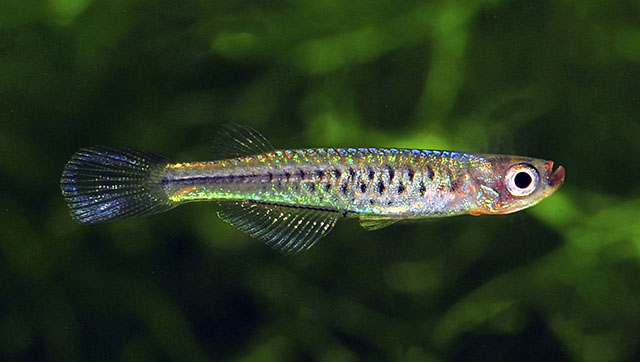|
Dorsal spines (total): 0-0; Dorsal soft rays (total): 6-7; Anal spines: 0-0; Anal soft rays: 15-17; Vertebrae: 31-31. Diagnosis: This species is distinguished from all other Hylopanchax species by its extreme slender body (body depth 16.3-20.0% of standard length vs. 20.8-35.5% in standard length), and small size of mature specimens, being maximum 21.2 mm standard length (Ref. 94189). Back almost straight and almost no difference in body depth between pectoral fin and anal fin versus convex back and greatest body depth always between pelvic and anal fin in other species of Hylopanchax (Ref. 94189).
Description: A very small Hylopanchax species, moderately laterally compressed; dorsal profile almost straight to slightly convex; body depth almost the same between pectoral and anal fin; ventral profile slightly convex from head to end of anal fin; snout very short and straight in dorsal view, mouth directed upwards, lower jaw longer than upper jaw; on both jaws small slightly curved conical teeth, the outer row larger, inner teeth row more irregular arranged with smaller teeth; symphysis forming a ridge on lower and less on upper jaw; branchiostegal appendages present in adult males (Ref. 94189). Frontal or nasal neuromasts not present, one pre-orbital neuromast in short shallow open groove; post-orbital and supra-orbital neuromast system provided with large neuromasts and large lobes, pre-opercular neuromast system with 5 pores (Ref. 94189). Scales cycloid, body completely scaled except ventral head surface, one row of scales underneath the eye, frontal squamation of G-type, no scales on dorsal and anal fin base, scales on mid-longitudinal series 23-26 (Ref. 94189). Number of dorsal fin rays 6-7, anal fin rays 15-17, caudal fin rays 20-24, pelvic fin rays 6, pectoral fin rays 8-10; first dorsal fin ray above anal fin ray 11-14 (Ref. 94189).
Colouration: Males have back greyish brown, becoming gradually lighter towards ventral side; flanks with two to three rows of scales anteriorly edged with black crescent shaped markings, third (vetral) row sometimes vague or missing: median fins yellowish with broad transparent blue margin, pelvic fin yellowish, pectoral fins translucent; anal fin with broad dark outer edge and narrow black band at base; urogenital papilla black (Ref. 94189). Females have body coulour as males and all fins translucent (Ref. 94189). |

